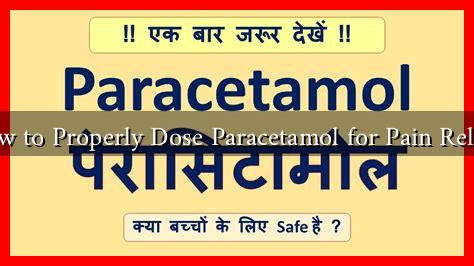-
Table of Contents
How to Properly Dose Paracetamol for Pain Relief?
Paracetamol, also known as acetaminophen, is one of the most commonly used medications for pain relief and fever reduction. Its effectiveness and relatively low side effect profile make it a go-to choice for many individuals. However, proper dosing is crucial to ensure safety and efficacy. This article will guide you through the appropriate dosing of paracetamol, its mechanisms, potential risks, and important considerations.
Understanding Paracetamol
Paracetamol is classified as a non-opioid analgesic and antipyretic. It works primarily in the brain, where it inhibits the production of prostaglandins, chemicals that promote inflammation and pain. Unlike NSAIDs (non-steroidal anti-inflammatory drugs), paracetamol does not have significant anti-inflammatory properties, making it suitable for various types of pain, including:
- Headaches
- Muscle aches
- Arthritis
- Back pain
- Toothaches
- Menstrual cramps
Recommended Dosage Guidelines
The recommended dosage of paracetamol varies based on age, weight, and specific health conditions. Here are general guidelines:
Adults
- The standard dose is 500 mg to 1000 mg every 4 to 6 hours.
- The maximum daily dose should not exceed 4000 mg.
- For chronic pain management, consult a healthcare provider for tailored dosing.
Children
- Dosage is typically based on weight: 10-15 mg/kg per dose.
- Doses can be repeated every 4 to 6 hours, but the total daily dose should not exceed 60 mg/kg.
- Always use a pediatric formulation and measuring device for accuracy.
Factors Influencing Dosage
Several factors can influence the appropriate dosage of paracetamol:
- Age: Older adults may metabolize drugs differently, necessitating lower doses.
- Weight: Heavier individuals may require higher doses, while lighter individuals may need less.
- Health Conditions: Liver disease or chronic alcohol use can significantly affect how paracetamol is processed in the body.
Risks of Overdosing
While paracetamol is generally safe when taken as directed, overdosing can lead to severe liver damage. According to the American Association of Poison Control Centers, paracetamol overdose is one of the most common causes of acute liver failure in the United States. Symptoms of overdose may include:
- Nausea and vomiting
- Loss of appetite
- Confusion or unusual behavior
- Jaundice (yellowing of the skin and eyes)
If an overdose is suspected, it is crucial to seek medical attention immediately. The antidote, N-acetylcysteine (NAC), is most effective when administered within 8 hours of ingestion.
Case Studies and Statistics
Research indicates that paracetamol is effective for various pain types. A systematic review published in the Journal of Pain Research found that paracetamol is as effective as NSAIDs for treating acute pain conditions. However, it is essential to adhere to dosing guidelines to avoid complications.
Statistics show that in the U.S., paracetamol accounts for over 50% of all drug overdoses reported to poison control centers. This highlights the importance of education regarding safe dosing practices.
Conclusion
Paracetamol is a widely used and effective medication for pain relief when taken correctly. Understanding the appropriate dosing guidelines, considering individual factors, and being aware of the risks associated with overdose are crucial for safe use. Always consult a healthcare provider if you have any doubts about dosing, especially for children or individuals with pre-existing health conditions. By following these guidelines, you can effectively manage pain while minimizing the risk of adverse effects.



